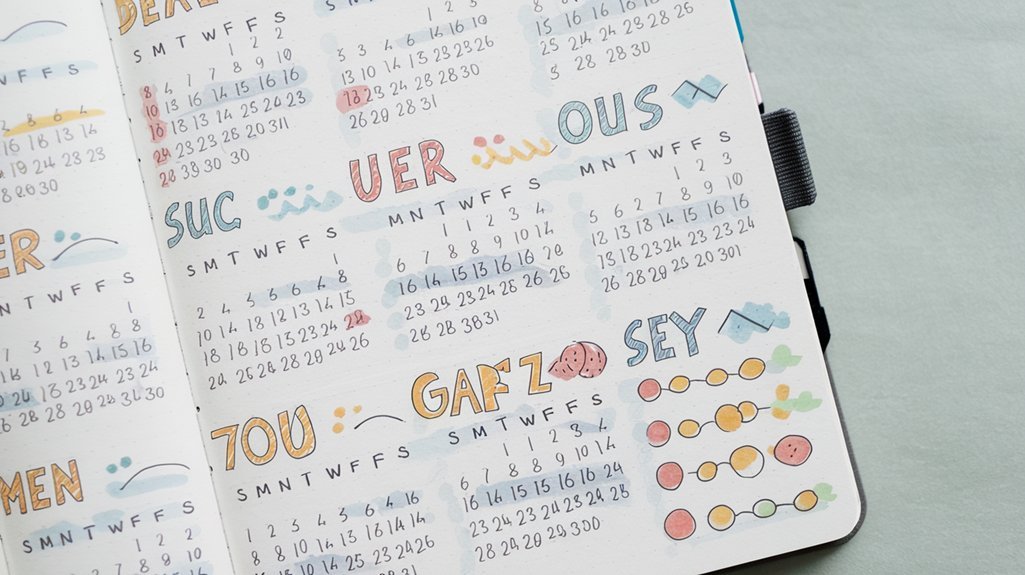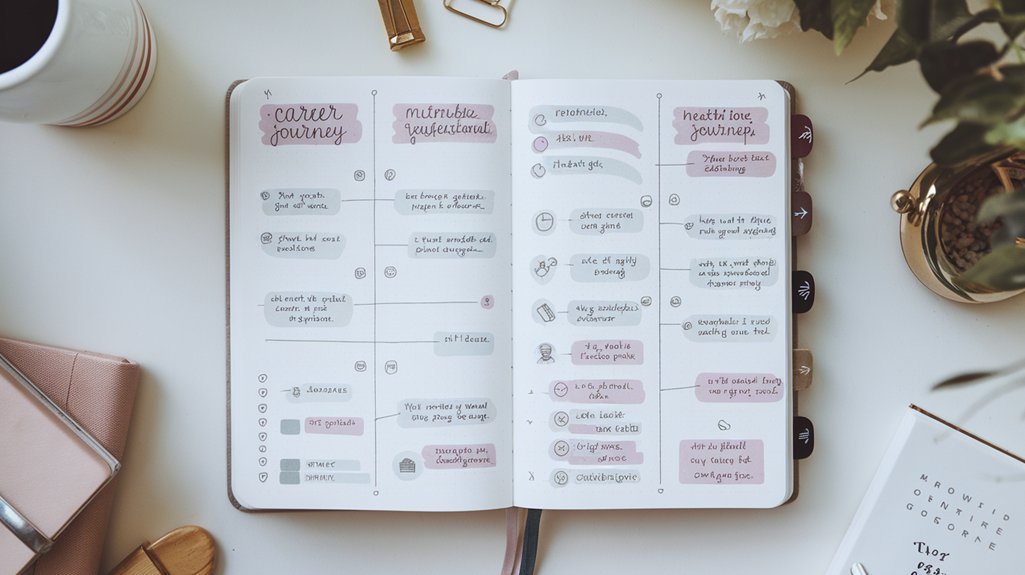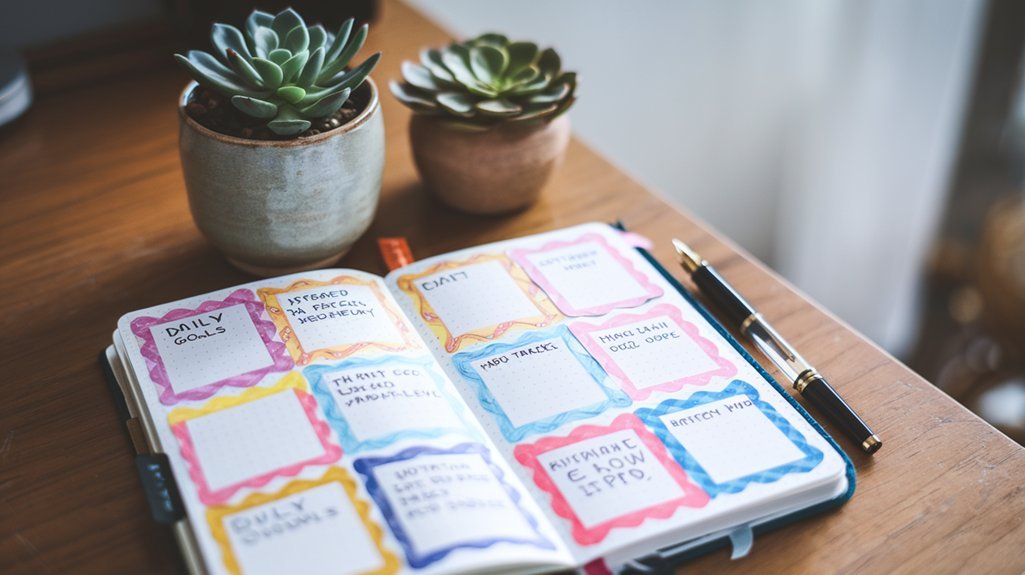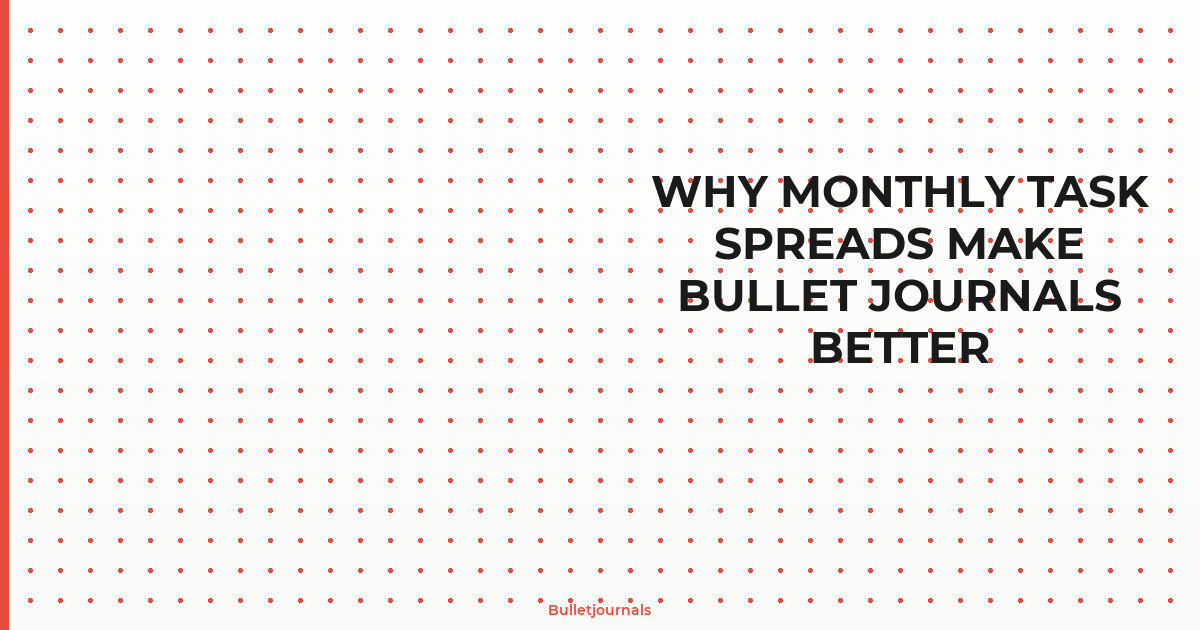A vision board bullet journal transforms dreams into reality by combining creative visualization with structured planning. Starting with a dot-grid notebook, creators gather inspiring images, quotes, and materials to represent their goals. The process involves selecting a cohesive theme, establishing clear intentions using the SMART framework, and incorporating tracking systems for progress. Regular updates and reviews maintain momentum, while artistic elements keep motivation high. This powerful tool offers a complete roadmap for achieving life's most meaningful aspirations.
What Is A Vision Board Bullet Journal

A vision board bullet journal combines the creative inspiration of traditional vision boards with the practical organization of bullet journaling to create a powerful tool for personal growth and goal achievement. It serves as a dedicated space where individuals can visually map their aspirations while maintaining structured planning systems.
A vision board traditionally consists of images, quotes, and symbols that represent desired goals and dreams, helping to maintain focus on specific life objectives. A bullet journal functions as a customizable organization system that tracks tasks, events, and notes through simple bullet points and symbols. When these two concepts merge, they form a dynamic notebook that not only displays inspirational elements but also breaks down the actionable steps needed to transform those visions into reality. This hybrid approach allows users to stay motivated by their dreams while implementing practical strategies to accomplish them, creating an extensive system for personal development and success tracking.
Essential Supplies And Materials
Success in creating a vision board bullet journal begins with gathering the right supplies and materials. The foundation starts with selecting the right journal, with options ranging from dot-grid notebooks to blank sketchbooks. High-quality paper types that can withstand various mediums without bleeding or ghosting are essential for maximum results.
Key stationery recommendations include fine-liner pens in multiple colors, highlighters, and brush markers for artistic elements. Additional supplies encompass washi tape for decorative borders, sticky notes for temporary placements, and adhesive tabs for easy navigation. A ruler or stencils help maintain clean lines and consistent layouts.
For the vision board elements, one should collect magazines, printed photographs, inspirational quotes, and decorative papers. Adhesives like glue sticks or double-sided tape guarantee secure attachment of visual elements. Optional tools include scissors with precision tips, a paper cutter for straight edges, and clear page protectors to preserve completed spreads.
Choosing Your Journal Theme And Layout
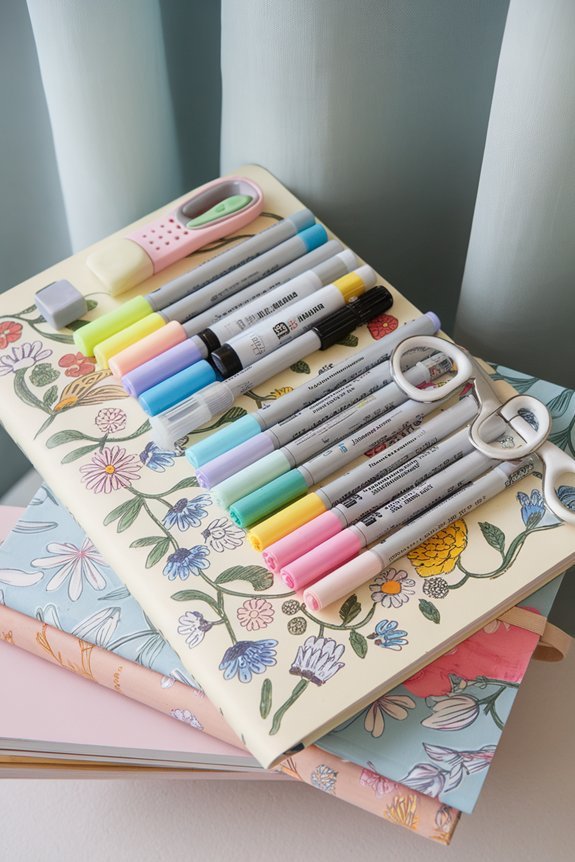
Selecting a cohesive color scheme and recurring motifs sets the foundation for a visually engaging vision board bullet journal. The chosen theme can range from minimalist monochrome to vibrant rainbows, incorporating personal symbols and decorative elements that resonate with individual goals. Strategic layout design with designated sections helps organize different life aspects, making the journal both aesthetically pleasing and functionally effective.
Color Schemes and Motifs
The perfect vision board bullet journal begins with thoughtful color schemes and cohesive design motifs that reflect one's goals and aspirations. Selecting complementary colors and consistent patterns creates a harmonious visual experience that enhances motivation and focus. Pastel gradient patterns can evoke feelings of growth and progression, while textured background designs add depth and visual interest to each page.
- Choose a primary color palette that resonates with specific goals
- Incorporate metallic accents for emphasis on key achievements
- Use consistent motifs throughout sections for visual continuity
- Apply color psychology principles to enhance emotional impact
- Layer patterns strategically to create visual hierarchy
These design elements work together to transform the journal into a powerful visualization tool, making goals feel more tangible and achievable while maintaining an organized and aesthetically pleasing layout that inspires daily action.
Layout Design and Sections
While designing a vision board bullet journal's layout, creators must first establish clear sections that align with their life aspirations and goals. The layout composition should flow naturally, dividing the journal into key areas such as career, relationships, health, and personal growth.
Visual organization plays an indispensable role in making the vision board effective and engaging. Creators can designate specific spreads for different timeframes: daily reflections, monthly goals, and long-term aspirations. Each section can feature dedicated spaces for images, affirmations, and progress tracking. The layout should incorporate both structured elements, like calendars and habit trackers, and flexible spaces for spontaneous inspiration and creative expression. Deliberate placement of sections ensures that users can easily navigate their vision board while maintaining a cohesive and purposeful design throughout the journal.
Setting Clear Goals And Intentions
Creating a vision board bullet journal starts with mapping out key life areas and defining meaningful goals. Clear intentions across categories like career, relationships, health, and personal growth provide the foundation for transformative change. Breaking down each goal into specific, measurable action steps transforms abstract aspirations into achievable milestones that can be tracked and celebrated.
Map Your Life Focus
Mapping life focus serves as the foundation for a compelling vision board bullet journal. Through self reflection and daily mindfulness, individuals can identify core areas that matter most to their personal growth and fulfillment.
- Career aspirations and professional development goals
- Health and wellness priorities, including mental and physical balance
- Relationships and social connections to nurture
- Personal growth, including spiritual and emotional development
- Financial objectives and lifestyle aspirations
Creating a life focus map helps organize thoughts and priorities into clear, actionable categories. This structured approach enables better decision-making and resource allocation across different life domains. By understanding where to direct energy and attention, individuals can craft meaningful goals that align with their values and desired outcomes, making their vision board more purposeful and achievable.
Define Measurable Action Steps
Transforming broad aspirations into concrete action steps marks a critical transformation in vision board bullet journaling. The process requires breaking down larger goals into smaller, manageable tasks that create a clear pathway to success. As individuals define achievable milestones, they gain a tangible roadmap for their journey.
Every action step should include specific deadlines, resource requirements, and outline performance metrics to track progress effectively. For example, rather than writing “get healthy,” one might specify “walk 30 minutes daily” or “meal prep every Sunday.” This precise approach eliminates ambiguity and creates accountability. The key lies in establishing SMART goals – Specific, Measurable, Achievable, Relevant, and Time-bound – ensuring each step moves purposefully toward the larger vision while maintaining realistic expectations for implementation and achievement.
Creating Your Vision Board Elements

Once the foundational layout is complete, selecting and organizing vision board elements becomes an exciting journey of self-discovery. The process requires thoughtful consideration of visually engaging elements that resonate with personal goals and aspirations. Each meaningful imagery selected should spark motivation and serve as a powerful reminder of desired outcomes.
Creating impactful vision board elements involves:
- Collecting inspiring photographs that represent specific goals
- Including powerful quotes or affirmations that align with personal values
- Adding color schemes that evoke desired emotions and energy
- Incorporating symbols or icons that represent milestones
- Using relevant words or phrases that capture intended achievements
These carefully chosen elements work together to create a cohesive visual representation of future aspirations. The key lies in selecting items that genuinely connect with personal dreams while maintaining a balanced and aesthetically pleasing arrangement. When assembled thoughtfully, these elements transform the bullet journal into a powerful tool for manifestation and goal achievement.
Organizing Your Spreads And Collections
A well-organized vision board bullet journal requires strategic arrangement of spreads and collections to maximize its effectiveness. The key lies in creating a structured system that allows for easy navigation while maintaining visual appeal and functionality. By categorizing collections into specific life areas such as career, relationships, health, and personal growth, users can maintain a clear overview of their aspirations.
Organizing section dividers serves as the foundation for a seamless journaling experience. These dividers can be embellished with color-coding, tabs, or artistic elements that reflect the theme of each category. The strategic placement of related spreads near each other creates natural flow and encourages regular engagement with goals. Monthly, weekly, and daily spreads should be arranged chronologically, while theme-based collections can be grouped according to their relevance or priority. This systematic approach guarantees that every vision board element has its designated space, making it easier to track progress and maintain focus on desired outcomes.
Adding Visual Elements And Inspiration

While the structural foundation of a vision board bullet journal is essential, visual elements and inspiration transform it into a powerful motivational tool. The process of selecting collage material and gathering visual inspiration sources allows creators to manifest their goals through imagery that resonates deeply with their aspirations.
Visual elements breathe life into vision board journals, turning dreams into tangible inspiration through carefully curated imagery and meaningful design choices.
Effective visual elements can be incorporated through:
- Magazine cutouts featuring aspirational imagery, quotes, and relevant text
- Personal photographs that capture meaningful moments or desired outcomes
- Digital printouts from online sources, including Pinterest and Instagram
- Hand-drawn sketches, doodles, and artistic expressions
- Color swatches and patterns that evoke specific emotions or energy
The key lies in selecting visual elements that genuinely connect with personal goals and dreams. When arranging these components, creators should focus on creating a harmonious layout that tells their story while maintaining clarity and purpose. This thoughtful combination of imagery and intention helps transform abstract goals into tangible visual representations.
Incorporating Tracking Systems
To transform a vision board bullet journal from a collection of inspirational images into an actionable tool for success, incorporating effective tracking systems becomes essential. By implementing structured methods for monitoring progress, individuals can maintain accountability and measure their advancement toward specific goals.
Tracking habits within the journal can take various forms, from simple checkboxes and progress bars to more elaborate spreads that detail daily, weekly, or monthly achievements. Users can create customized trackers for health goals, financial targets, skill development, or personal growth initiatives. These systems provide valuable data on patterns, challenges, and successes.
The key lies in selecting tracking methods that align with individual goals while remaining practical and sustainable. Color-coding, symbols, or numerical scales can enhance the visual appeal while maintaining functionality. Regular review of these tracking systems helps identify areas needing adjustment and celebrates milestones achieved along the journey.
Monthly Vision Planning Templates

Monthly vision planning templates combine purposeful layout designs with action tracking to transform abstract goals into achievable outcomes. A well-structured template features dedicated spaces for goal visualization, milestone tracking, and daily progress markers that align with the broader vision. Strategic layout choices, such as grid-based designs and color-coded sections, create an organized framework that empowers users to monitor their journey while maintaining focus on their monthly objectives.
Layout Design Tips
Designing an effective vision board layout starts with three essential templates: the goal grid, the inspiration timeline, and the action map. The layout typography should remain consistent throughout, using clear fonts that inspire action while maintaining readability. Strategic layout spacing guarantees each element has room to breathe and impact.
Key design principles for vision board layouts include:
- Use contrasting colors to highlight priority goals and achievements
- Incorporate white space strategically to prevent visual overwhelm
- Align elements along a clear grid system for professional organization
- Select complementary fonts – one for headers, another for details
- Maintain consistent margins and spacing between sections
These layout fundamentals create a visually appealing and functional vision board that encourages daily interaction and goal progression. The design should ultimately serve to motivate and inspire while remaining practical and easy to navigate.
Monthly Action Tracking
Successfully tracking monthly vision progress requires purposeful templates that transform abstract goals into measurable actions. Creating organized daily activity logs enables individuals to monitor routine accomplishments while staying aligned with their broader vision.
| Vision Category | Monthly Action Items |
|---|---|
| Personal Growth | Reading, Meditation |
| Career Goals | Skills Training, Networking |
| Health/Fitness | Exercise, Meal Planning |
| Relationships | Quality Time, Communication |
| Creative Projects | Writing, Art Making |
The monthly tracking system serves as a bridge between aspirational goals and concrete achievements. By breaking down larger objectives into smaller, manageable tasks, individuals can maintain momentum and celebrate incremental progress. This systematic approach transforms vague intentions into tangible results, making it easier to identify patterns, adjust strategies, and maintain accountability throughout the vision-realization journey.
Color Coding And Symbol Systems
Organization flourishes through an effective color coding and symbol system in a vision board bullet journal. Implementing a thoughtful color harmony scheme helps categorize goals, tasks, and aspirations while maintaining visual appeal. Symbol coordination creates a quick-reference system that enhances efficiency and clarity across journal pages.
- Use warm colors (red, orange, yellow) for urgent or high-priority goals
- Assign cool colors (blue, green, purple) to personal growth and wellness tasks
- Create simple geometric symbols for recurring items like appointments or deadlines
- Design intuitive icons for emotional states or energy levels
- Maintain a legend page for quick reference to all colors and symbols
The combination of purposeful colors and meaningful symbols transforms the bullet journal into a powerful visualization tool. This systematic approach allows for instant recognition of different elements while maintaining an organized and aesthetically pleasing layout that supports goal achievement and personal development.
Combining Photos And Written Goals

The strategic placement of inspiring photos alongside written goals creates a powerful visual-verbal connection in a vision board bullet journal. Creating dedicated spreads that pair aspirational images with specific, measurable goals helps reinforce desired outcomes through multiple sensory channels. Positioning photos of dream destinations, career milestones, or lifestyle goals directly next to written action steps transforms abstract wishes into concrete, achievable targets.
Creating Inspiring Photo Spreads
When vision and creativity merge in a bullet journal spread, photos become powerful catalysts for goal achievement. Creating dynamic photo collages that align with personal aspirations helps transform abstract dreams into visual stepping stones. Inspirational imagery carefully arranged in themed layouts provides daily motivation and reinforces commitment to goals.
- Choose a cohesive color scheme that evokes desired emotions
- Layer photos with varied sizes to create visual interest and depth
- Include meaningful quotes that complement the chosen images
- Group related photos together to tell a compelling story
- Leave white space around photos to prevent visual overwhelm
The key to effective photo spreads lies in thoughtful curation and intentional placement. Each image should serve as a reminder of specific goals while contributing to an overall aesthetic that energizes and inspires action.
Writing Goals Beside Images
Pairing powerful images with clearly articulated goals creates a synergistic effect that amplifies manifestation potential in vision board bullet journals. When combining visual elements with meaningful goal statements, practitioners should place their written objectives directly beside corresponding images, creating an immediate mental connection between aspiration and outcome.
The written goals should be specific, measurable, and time-bound, complementing the tangible visual elements on each page. For example, beside a photo of a dream home, one might write “Purchase a 3-bedroom coastal property by December 2024.” This precise combination of imagery and text helps the brain process both the emotional and logical aspects of each goal, making it easier to envision and pursue the desired outcome with clarity and purpose.
Making Your Goals Measurable
Making goals measurable transforms vague aspirations into actionable targets that can be tracked and achieved. By incorporating key performance indicators and quantifiable milestones into vision board bullet journal entries, individuals can monitor their progress effectively and maintain momentum toward their objectives.
- Replace “be healthier” with “exercise 30 minutes daily, 5 times per week”
- Transform “save money” into “deposit $500 monthly into savings account”
- Convert “read more” to “complete one book every two weeks”
- Change “learn a language” to “master 20 new vocabulary words weekly”
- Specify “travel more” as “visit 3 new countries within 12 months”
Each measurable goal creates a clear pathway for success and eliminates ambiguity. When journaling these specific targets, tracking becomes systematic and motivation increases naturally. The process of measuring progress provides valuable feedback, allowing for adjustments and celebrations of achievements along the way.
Maintaining Consistency And Progress

Successful vision board bullet journaling relies on consistent engagement and regular progress tracking. By establishing a daily or weekly review routine, individuals can maintain momentum toward their visualized goals while staying accountable to their aspirations.
Progress monitoring becomes more effective when coupled with specific check-in times, such as Sunday evening reviews or monthly assessments. During these sessions, one should evaluate completed tasks, adjust timelines if necessary, and celebrate small victories. This systematic approach helps in maintaining focus and prevents goals from becoming stagnant or forgotten.
To enhance consistency, users can implement simple tracking methods like color-coding tasks, using progress bars, or creating milestone markers. These visual indicators serve as powerful reminders and motivation boosters. When setbacks occur, reviewing the vision board's original intention helps realign focus and reignite commitment to the desired outcomes, ensuring steady progress toward manifesting goals.
Weekly Review And Update Methods
Weekly reviews form the backbone of an effective vision board bullet journal practice. Through consistent weekly reflection sessions, individuals can track their journey and maintain alignment with their visualized goals. These structured reviews provide clarity on accomplishments and areas needing adjustment.
A thorough weekly review should include these essential elements:
- Reviewing completed tasks and celebrating small wins
- Documenting progress updates toward vision board goals
- Identifying obstacles and brainstorming solutions
- Setting focused intentions for the upcoming week
- Cross-referencing current activities with long-term vision
During each review session, practitioners should dedicate quiet time to assess their vision board pages, noting any patterns or insights that emerge. This process helps maintain momentum while allowing for necessary course corrections. The weekly review transforms abstract dreams into actionable steps, creating a bridge between inspiration and achievement. Regular updates keep the vision board bullet journal a dynamic tool for personal growth and goal attainment.
Conclusion
Vision board bullet journaling transforms ordinary goal-setting into an explosive catalyst for life-changing success. By masterfully blending visual inspiration with structured planning, this revolutionary system propels dreamers into unstoppable achievers. Those who harness this powerful combination of creativity and accountability don't just reach their goals – they absolutely demolish them. With unwavering commitment and a well-crafted vision board bullet journal, the impossible becomes not just possible, but inevitable.
Creative Supplies
Affiliate links – we earn from qualifying purchases.





